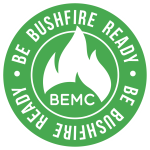The Bushfire Attack Level (BAL) measures the severity of a building’s potential exposure to radiant heat (as well as ember attack and direct flame) and is calculated through a series of bushfire behaviour and fire engineering calculations. There are two ways to determine the BAL.
- Simplified procedures, also referred to as Method 1. This method clusters values into incremental groups. The highest of the grouped value is used to read tabulated information to determine the BAL. Method 1 involves several basic steps to determine BALs. To simplify this approach several assumptions have been made which limits the circumstances in which it can be used.
- Detailed procedures, also referred to as Method 2, do not cluster or group inputs. Instead, specific data from the site or contemporary research is used. These inputs are placed into a sequence of bushfire behaviour and fire engineering calculations to determine the radiant heat exposure. Method 2 provides a specific result for the site, removing the assumptions within the Method 1 process. Both processes must be undertaken by a BPAD accredited practitioner. Method 1 is illustrated within Chapter 2, with Method 2 within Appendix B of the Australian Standard 3959 Construction of Buildings in Bushfire prone areas.
Both processes must be undertaken by a BPAD accredited practitioner. Method 1 is illustrated within Chapter 2, with Method 2 within Appendix B of the Australian Standard 3959 Construction of Buildings in Bushfire prone areas. The below table provides a quick summary of the advantages and disadvantages for both assessment methodologies.
| METHOD 1 (Simplified) | METHOD 2 (Detailed) | ||
|---|---|---|---|
| Advantages | Disadvantages | Advantages | Disadvantages |
| Cheap in price | ‘Back of the envelope’ assessment | Determine accurate inputs to calculations | More expensive |
| Completed quickly | Assumptions within processes | Achieves reduced radiant heat levels | Longer and more involved process |
| Appropriate only for recent subdivisions development | Results in a conservative radiant heat level | Can be implemented on any development type and situation | |
| Restricted by slope angles | Implemented on greater slope angles | ||
| Highest BAL level possible is recommended | Can build on this process to develop performance-based solutions | ||







